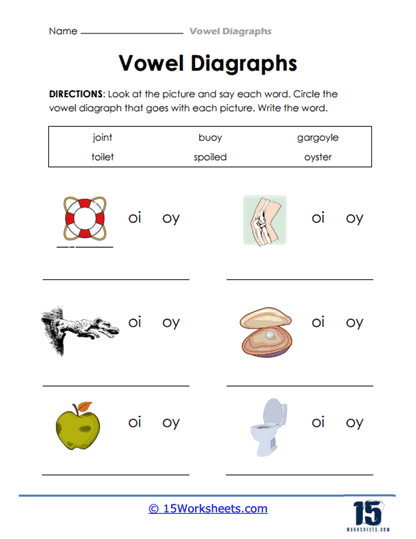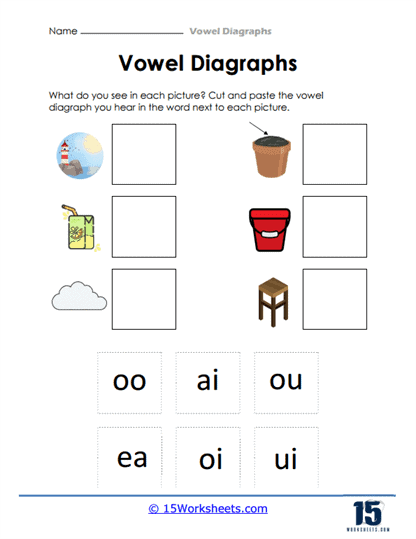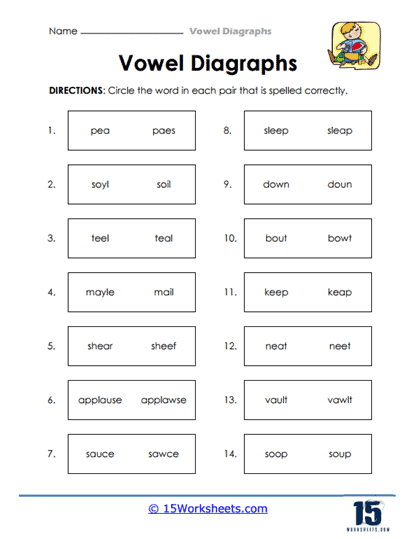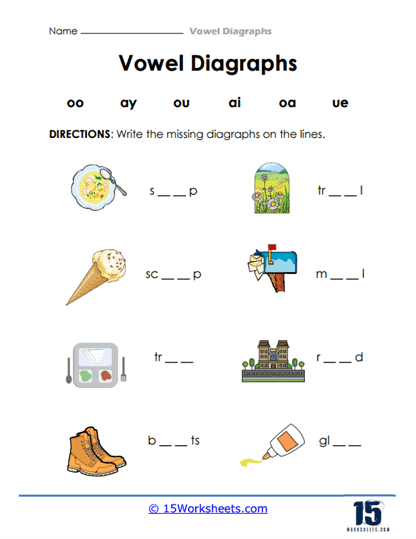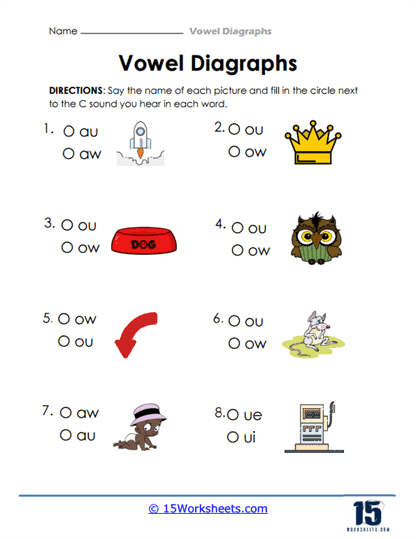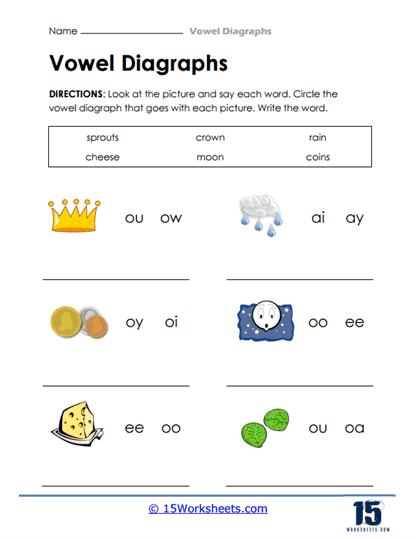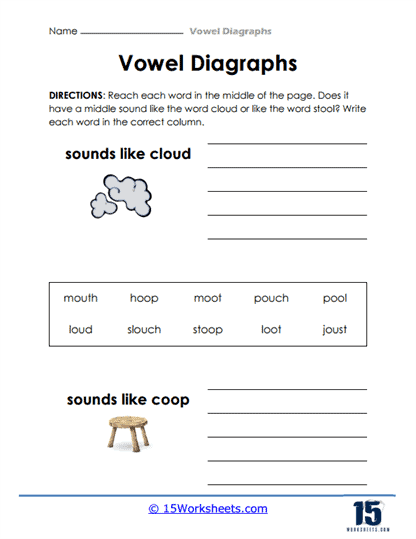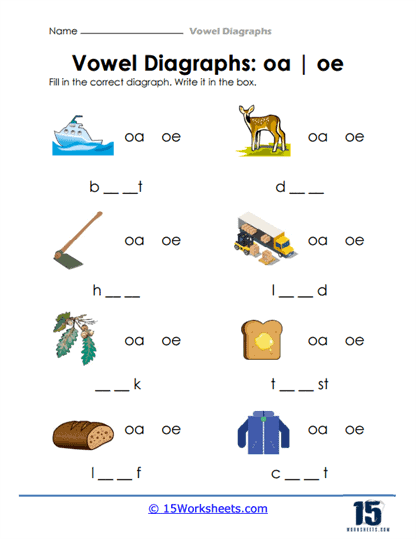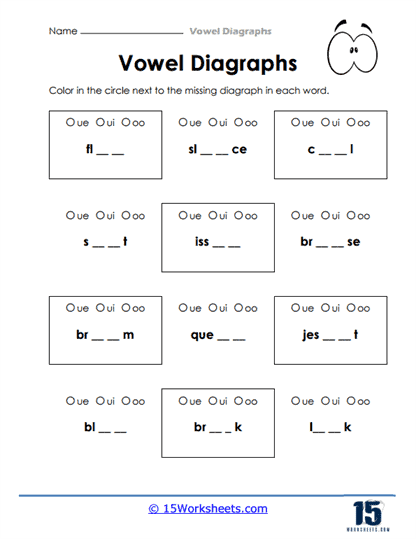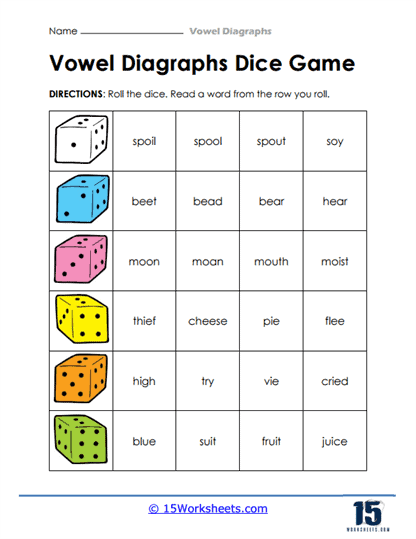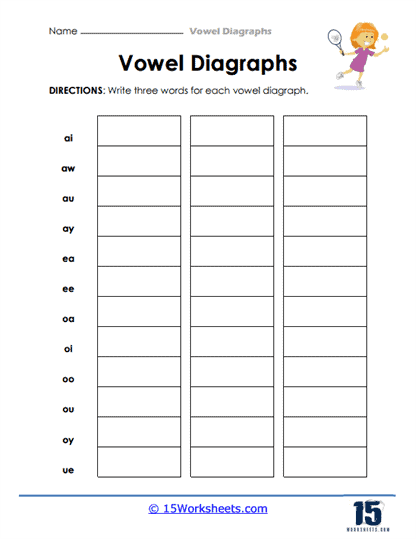Vowel Digraphs Worksheets
About These 15 Worksheets
This worksheet series is a comprehensive and engaging resource designed to help students master the concept of vowel digraphs-pairs of vowels that together create a single sound, such as “ai” in “rain” or “ea” in “seat.” This collection provides a wide range of activities that are suitable for students at different stages of their learning journey, making it an ideal tool for both teachers in traditional classrooms and parents who homeschool. Each worksheet is available in PDF format, making it easy to view, download, and print, ensuring that you have a convenient and accessible resource at your fingertips.
One of the key features of this collection is the use of picture-based activities to reinforce the learning of vowel digraphs. For example, students are asked to look at pictures and identify the vowel digraph they hear in the word associated with each image. They then write the digraph in the provided box. This type of activity is particularly effective for visual learners, as it connects the visual representation of the word with its phonetic components. By associating words with images, students can more easily remember the spelling and pronunciation of words with vowel digraphs.
Another popular activity in this collection involves fill-in-the-blank exercises, where students are given a word with missing vowel digraphs. Their task is to choose the correct digraph from a list of options and complete the word. This type of exercise is excellent for reinforcing spelling skills and ensuring that students understand how vowel digraphs function within different word contexts. These worksheets encourage students to think critically about word structure and to apply their knowledge of vowel digraphs in a practical way.
The collection also includes coloring and matching activities, which are both fun and educational. In these worksheets, students are asked to color the square with the correct vowel digraph that corresponds to the picture. This type of activity is especially engaging for younger students, as it combines learning with a creative task. By adding an element of play, these worksheets help to keep students motivated and focused on the learning objectives.
Cut-and-paste activities are another highlight of the collection. Students are given a set of pictures along with cut-out vowel digraphs and are asked to match the correct digraph with the corresponding picture. This hands-on approach is particularly beneficial for kinesthetic learners who thrive when they can interact physically with the learning material. The process of cutting and pasting also helps to develop fine motor skills, making this activity both educational and physically engaging.
In addition to the more interactive activities, the collection includes worksheets that focus on word sorting and categorization. Students are asked to read a list of words and sort them into categories based on the vowel digraph they contain. This exercise encourages students to recognize patterns in word structure and to group words according to these patterns, reinforcing their understanding of how vowel digraphs operate in different word contexts. This activity is particularly useful for helping students develop a more nuanced understanding of phonics.
Spelling practice is a crucial component of mastering vowel digraphs, and this collection offers a variety of worksheets focused on spelling. Students are given incomplete words and are required to fill in the correct vowel digraph to complete the word. These exercises not only test students’ knowledge of vowel digraphs but also help to improve their overall spelling skills. By repeatedly practicing how to spell words with vowel digraphs, students become more confident in their ability to use these words in writing.
To add an element of fun and competition to the learning process, the collection includes dice games where students roll a die and then read a word from the row corresponding to the number rolled. Each row contains words with different vowel digraphs, ensuring that students are exposed to a variety of examples. This game-like format adds excitement to the learning process, making it an excellent tool for group activities in the classroom or for family game time in a homeschool setting.
Another type of worksheet in the collection focuses on word recognition, where students are asked to circle the word in each pair that is spelled correctly. This activity helps students to quickly identify correct and incorrect spellings, reinforcing their knowledge of vowel digraphs in a practical, real-world context. These quick, focused exercises are perfect for reinforcing lessons or for use as warm-up activities at the beginning of a language arts lesson.
To further deepen students’ understanding of vowel digraphs, the collection includes worksheets that require students to write sentences using words that contain specific vowel digraphs. This exercise not only reinforces spelling but also encourages students to think about how these words are used in context. By constructing sentences, students can see how vowel digraphs fit into larger linguistic structures, helping to solidify their understanding of these important phonics elements.
Sound-based word sorting is another engaging activity featured in the collection. Students are presented with a list of words and are asked to sort them based on the vowel sound they hear in the middle of the word. For example, they might sort words into two columns: those that have the same middle sound as “cloud” and those that have the same middle sound as “stool.” This activity helps students to fine-tune their phonemic awareness and to better understand how vowel digraphs influence pronunciation.
Whether you’re a teacher looking to supplement your phonics curriculum or a homeschooling parent in need of structured, effective materials, these worksheets provide a comprehensive solution. The engaging, interactive nature of the activities ensures that students remain motivated and focused while mastering this essential aspect of English phonics. Downloadable in PDF format, these worksheets are easy to access, making them a convenient and versatile addition to any educational toolkit.
What Are Vowel Digraphs?
Vowel digraphs are pairs of vowels that together create a single, unified sound, rather than each vowel producing its own separate sound. Common examples of vowel digraphs include “ai” as in “rain,” “ea” as in “seat,” and “oa” as in “boat.” Unlike vowel blends where each vowel retains its sound, vowel digraphs blend seamlessly to produce a specific phoneme. These digraphs are an essential aspect of English phonics because they represent a fundamental building block in the process of decoding words during reading and spelling.
In phonics, vowel digraphs play a crucial role in helping students understand the complexities of English spelling and pronunciation. English is a language where the same letter combinations can produce different sounds depending on the word, and vowel digraphs are a perfect example of this. For instance, the “ea” in “bread” sounds different from the “ea” in “seat.” By learning about vowel digraphs, students begin to understand these patterns, which in turn helps them predict the pronunciation of new words they encounter. This knowledge is vital for developing reading fluency, as it allows readers to decode words more quickly and with greater accuracy.
In addition to aiding pronunciation, vowel digraphs are instrumental in teaching spelling. Understanding how vowel digraphs work helps students grasp why certain words are spelled the way they are, even when the spelling doesn’t seem to match the pronunciation. For example, knowing that “ie” can produce a long “e” sound, as in “chief,” helps students remember the correct spelling of such words. This understanding reduces confusion and improves spelling accuracy, which is particularly important in English, where spelling rules often have numerous exceptions.
Beyond pronunciation and spelling, vowel digraphs also support the development of reading comprehension. When students can quickly and accurately decode words, they spend less cognitive energy on figuring out how to pronounce words and can focus more on understanding the meaning of the text. This fluency in reading is essential for comprehension, as it allows students to read more smoothly and with better expression. The ability to recognize vowel digraphs and their associated sounds is a stepping stone to achieving this level of reading proficiency.





